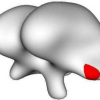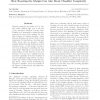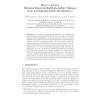26354 search results - page 79 / 5271 » How we refactor, and how we know it |
ICCV
2003
IEEE
14 years 11 months ago
2003
IEEE
In this paper, we overcome a major drawback of the level set framework: the lack of point correspondences. We maintain explicit backward correspondences from the evolving interfac...
ICML
2006
IEEE
14 years 10 months ago
2006
IEEE
Boosting methods are known not to usually overfit training data even as the size of the generated classifiers becomes large. Schapire et al. attempted to explain this phenomenon i...
ALT
2002
Springer
14 years 6 months ago
2002
Springer
Abstract. We consider a problem that is related to the “Universal Encoding Problem” from information theory. The basic goal is to find rules that map “partial information”...
CSCW
2010
ACM
14 years 3 months ago
2010
ACM
The schema or mental structures that people apply towards other people has been shown to influence the way people cooperate with others. Schemas evoke behavioral scripts. In this ...
ACIIDS
2009
IEEE
14 years 3 months ago
2009
IEEE
—Bandwidth allocation is a fundamental problem in communication networks. With current network moving towards the Future Internet model, the problem is further intensified as net...



